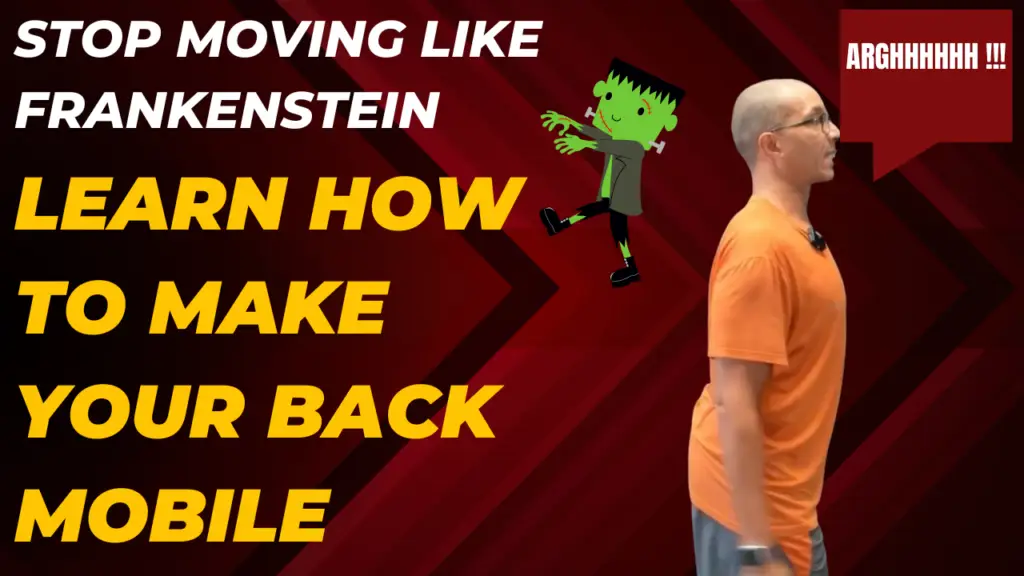
Click on the image to watch
If your back feels stiff and stuck—and you’re tired of moving like Frankenstein—it’s time to look at back mobility from a deeper perspective.
Most routines you see online might feel good temporarily, but they don’t address the root cause.
And in many cases, they can actually make things worse.
Here’s why.
What Is Mobility, Really?
Mobility is the ability of your joints and tissues to move freely in all the directions they were designed to move.
It’s not the same as flexibility.
You can be flexible (like touching your toes) without having true mobility (like moving smoothly under load or rotation).
Mobility is functional.
It helps your body perform well, stay pain-free, and move with strength.
But it requires more than a few stretches.
You need structure. You need muscle. And you need balance.
The Anatomy of Real Back Mobility
Your back isn’t just one unit.
It’s a coordinated system of:
- Four spinal curves (sacral, lumbar, thoracic, cervical)
- Deep and superficial core muscles
- Fascia, joints, and connective tissues
If you lose the natural curves in your spine—say your lumbar spine flattens—you lose structural integrity.
Your spine becomes weaker, more fragile, and less mobile.
Mobility isn’t about forcing range.
It’s about having the right alignment and the right strength to support movement.
At SolCore Fitness, we rebuild that foundation with a fascia-first lens—using tools like segmental strengthening and osteopathic training principles.
Why Routines Alone Don’t Work
Most YouTube videos show the same spinal twists and cobra stretches.
They feel good—for a moment.
But twisting a compressed spine can make things worse.
That’s because twisting compresses the discs between vertebrae. If your spine lacks space or alignment, you’re grinding into vulnerable tissue every time you rotate.
Over time, this leads to:
- Herniated discs
- Nerve impingement
- Chronic tension and compensation
Before you stretch or twist, your spine needs:
- Proper space and alignment
- Muscular balance and activation
- Awareness of how your body compensates
The Real Process for Unlocking Back Mobility
If you want lasting mobility, follow this sequence:
1. Rebuild Spinal Curves and Space
Mobility requires decompression. Without space between vertebrae, movement will always be restricted.
We use ELDOA, myofascial techniques, and postural re-education to reintroduce this space.
2. Strengthen in All Directions
Your core isn’t just abs. It includes obliques, transverse abdominis, spinal stabilizers, and many supporting muscles.
You need to strengthen in rotation, side-bend, extension, and flexion—not just planks.
Back and front must work together, not in isolation.
This approach is central to our personalized therapy and training plans.
3. Move with Intention
Only after steps 1 and 2 can you begin applying movement patterns that support your mobility.
Even then, it’s not about routines—it’s about selecting movements that fit your body’s needs and structural state.
That’s why we don’t give cookie-cutter programs.
You’re not a cake. Your body isn’t built from a recipe.
You Need a System, Not a Shortcut
You’ve probably tried a few of those “10-minute mobility fixes.”
Maybe they felt good… until they didn’t.
True mobility is sustainable. It works with your body—not against it.
And it honors the complexity of your spine, fascia, and nervous system.
Want to learn what a real back mobility program looks like?
Start with our free holistic fitness guide, or book a consult and we’ll walk through what’s keeping you stuck and what needs to change.
You’re not meant to live in restriction.
With the right strategy, your back can feel strong, mobile, and free—so you can move the way life intended.
it’s not just working out, it’s building a foundation for a better life.
Find out more @

Leave a Reply